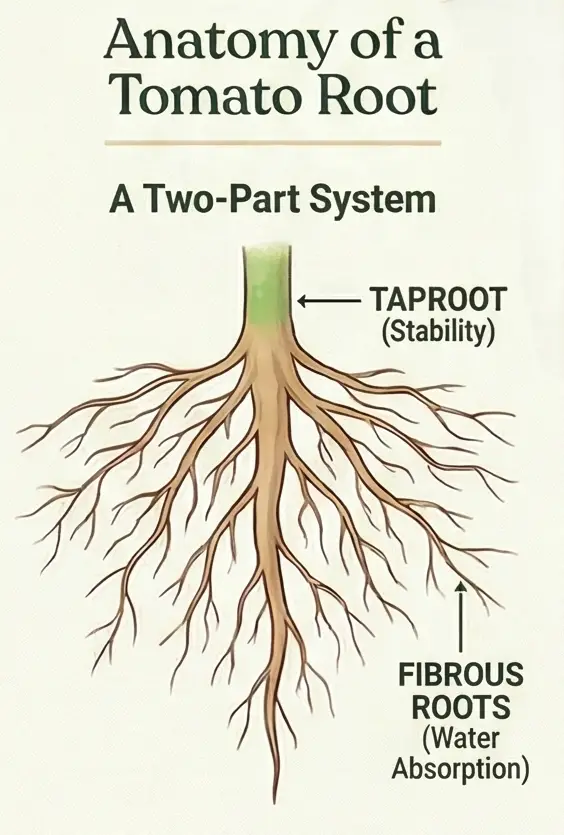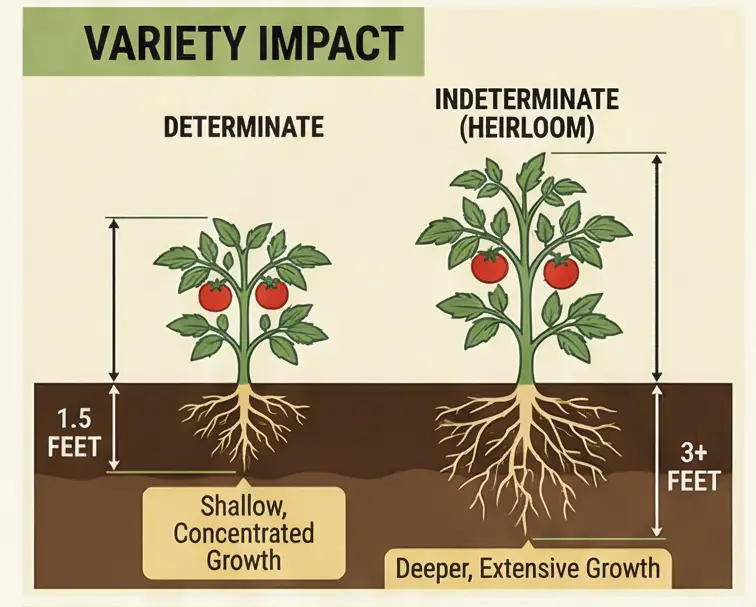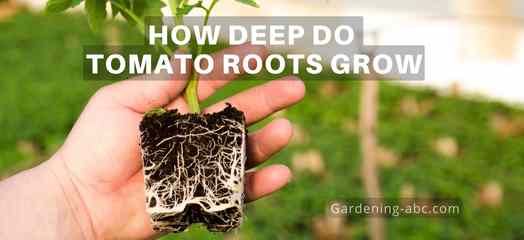We use affiliate links to run our site. When you buy through links on our site, we may earn an affiliate commission, without any added cost to you. Learn more
Tomato plants are able to grow deep into the ground because of their root system. The consists of several different parts, including the taproot, main roots, and lateral roots.
The tomato root system is a complex and important part of the plant. It plays an important role in the plants’ ability to access water and nutrients, and it helps the plant to grow.
Here in this post, we will discuss the tomato root system and exactly how deep the tomato roots can grow.
By understanding the root system of tomatoes, you can create a more efficient garden layout and produce larger, healthier tomatoes.
So let’s begin…
What Root System Does a Tomato Plant Have?
The root system has two parts: a taproot system and fibrous roots.
The taproot system is made up of one large root that goes down deep into the soil. This root helps the plant get water and nutrients from the soil.

The fibrous roots are made up of many small roots that spread out from the base of the plant. These roots help to anchor the plant in the soil and to take up water and nutrients from the soil.
This root system allows the tomato plant to absorb nutrients and water from a large area of soil.
How Deep Do Tomato Roots Go?
Tomato plants have deep roots that grow 3 feet or more into the soil. The roots will grow on top of the soil and will have a fibrous root system. However, there is also a taproot that goes deep into the soil. This helps to anchor the plant and find moisture and nutrients.
Although the tomato root can grow up to 3 feet in depth, you won’t find that happening every time. This is because there are several factors that affect how deep the root of a tomato plant would go.
Factors that affect the depth of a tomato plant’s Roots
Root depth is an important factor in tomato growing. It affects the yield, fruit size, and flavor of the tomatoes. Usually, the deeper the roots, the greater the yield and flavor.
There are a few factors that go into determining how deep the roots will grow. These include
- The variety of tomatoes being grown,
- The soil structure,
- The soil quality, and
- The planting technique.
Tomato Variety:
There are two types of tomato plants, determinate and indeterminate. The determinate variety is bushier and produces smaller fruit. This variety reaches a specific height and then flowers and fruits all at once.
The indeterminate variety is taller, has more vines, and produces larger fruit. This variety continues to grow until frost kills it. Heirloom tomatoes are the indeterminate type.

The depth of the tomato plant’s root system is related to the variety of the tomato plant. Determinate varieties have a shallower root depth than indeterminate varieties.
Heirloom tomatoes have a deeper root depth than most other varieties. This deeper root system allows heirloom tomatoes to access more water and nutrients, which results in larger fruit production.
Plum Tomatoes Vs Roma Tomatoes
Depth of the Container:
The depth of the container you are using to grow your tomatoes will greatly affect their root growth. The root growth is limited by pot size; the larger the pot, the larger the tomato’s root system.
This means that if you are growing your tomatoes in a shallow pot, their roots will not be able to grow very deep, which could limit their overall growth and production.
This can be a problem if you are trying to grow large tomatoes, as they need deep roots in order to get enough water and nutrients.
If you want your tomatoes to produce a large yield, it is best to use a pot that is at least 12 inches deep.
However, you can also get similar results by growing your tomatoes in raised beds. By creating elevated planting beds, you allow your plants’ roots to spread out more and grow deeper, resulting in bigger and healthier plants.
Soil Structure:
Soil structure is an important factor in plant growth. The physical properties of soil, such as texture and porosity, determine how well plants can access water and nutrients. Soil structure also affects root growth. If the soil structure is too compact, it can restrict tomato root growth.
The tomato roots grew significantly longer in the loose soils than in the compacted soils. The roots were also more evenly distributed in the loose soils than in the compacted soils.
Compacted soils can restrict plant root growth, leading to decreased uptake of water and nutrients. This can adversely affect plant growth and productivity.
Soil Quality:
Soil quality is an important factor for plant growth. The health of the soil is determined by the amount of nutrients and water present, as well as the texture and structure of the soil. Soil quality also affects how well plants can access these resources.
Tomato plants need well-drained soil with a pH between 6.0 and 7.0 to grow properly. The roots need access to both water and nutrients in order to thrive.
Soil high in nitrogen and potassium will produce healthy tomato plants with large root systems. Soil that is low in these nutrients will produce smaller plants with fewer roots.
You can improve poor soil quality by adding organic matter such as compost or mulch. This will help to improve the texture and structure of the soil, as well as add nutrients that plants can use.
Planting Technique:
When planting tomatoes, there are a few things to keep in mind in order to get the best results. One of those things is the depth at which you plant the seedlings.
Planting them too shallow can lead to problems with stability and wind resistance as well as poor root structure.
When tomato plants were planted deeply, their roots grew significantly longer than when they were planted more shallowly.
The deeper planting also results in a greater number of lateral roots, which helps to anchor the plants more securely and improves their resistance to wind damage.
If you’re looking for healthy, robust tomato plants with plenty of root growth, it’s best to plant them deeply. Here you can find more information about how to plant a tomato properly.
How Deep Should My Raised Bed Be?
Are you thinking of growing tomatoes in a raised bed? If so, how deep should your raised bed be? The answer depends on the different factors we have just discussed.
Most gardeners recommend a depth of 12 to 36 inches for raised beds. A depth of 12 inches in a raised bed is the minimum for growing tomatoes. Ideally, it should be around 24 inches (in most cases). Very rarely will you find a tomato plant root reach around 3 ft of depth.
If you have a bed that is less than 12 inches in depth, consider raising the height. Here are some useful tips on how to make a raised garden bed, see that help.
How to Encourage Root Growth in Tomatoes:
Encouraging root growth in tomato plants is essential for the overall health of the plant and for ensuring a good harvest.
One way to encourage healthy root growth is to transplant the tomato plants several times into a deeper container than the previous ones. This will give the roots more room to grow.
One way to encourage root growth in tomato plants is to provide them with rich and fertile soil. This can be done by adding compost or manure to the soil before planting the tomatoes.
Plant your tomato seedlings deep into the soil.
You can also water the plants regularly, making sure to provide plenty of moisture to the roots. If the soil is too dry, the roots will not grow properly.
You can remove some of the lower leaves from the plant. This will allow more air to reach the roots, which will help them grow better.
Finally, you can help stimulate root growth by using a fertilizer that is high in nitrogen.
This will help the roots grow down deep into the soil.
Tomato Plant Root Problem
Tomatoes are a popular garden crop because of their nutritional value and versatility in the kitchen. However, tomato plants can be susceptible to a number of common root problems that can cause them to fail.
The most common problems are corky root, fusarium crown rot, southern bacterial wilt, and phytophthora root rot.
Corky root is caused by a fungus that attacks the roots of the plant. This fungus can cause the roots to become covered with a thick layer of cork-like material.
Fusarium crown rot is caused by a bacterium that attacks the stem of the plant just below the soil line.
Southern bacterial wilt is caused by a bacterium that causes wilting and death of the plant. Phytophthora root rot is caused by a fungus that causes the roots to rot and die.
Prevention and Solution:
All of these problems can be prevented or treated by taking some simple steps. The most common root problems in a tomato plant are caused by a lack of proper soil preparation, poor crop rotation, and overwatering.
One way to prevent these problems is to make sure the soil is properly prepared before planting. This includes adding organic matter such as compost or manure and working it into the soil.
Rotate your crops each year so that the same plants don’t grow in the same spot every year.
Another way to prevent these problems is by using beneficial nematodes. These tiny creatures fight against harmful nematodes that can damage tomato plants.
They can be purchased from garden centers or online and are easy to use. Simply mix them with water and pour them on the soil around your plants.
Proper soil preparation, crop rotation, and the use of beneficial nematodes are all you need to do to prevent tomato root problems.


Conclusion:
Tomato plants can have a deep root system that can grow up to 3 feet deep! This is great news for gardeners because it means that the plants will be able to find water and nutrients even in drier soils.
Make sure to give your tomato plants plenty of room to grow by planting them in a garden plot with deep soil.
I hope you like the information discussed here. If you find the post helpful, please share it with others too.
Amazon and the Amazon logo are trademarks of Amazon.com, Inc, or its affiliates.


Hi there! My name is Prasenjit and I’m an avid gardener and someone who has grown a passion for growing plants. From my hands-on experience, I have learned what works and what doesn’t. Here I share everything I have learned.



